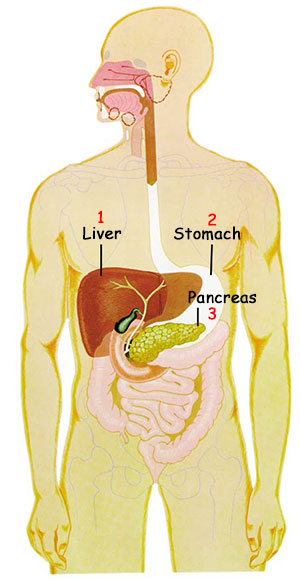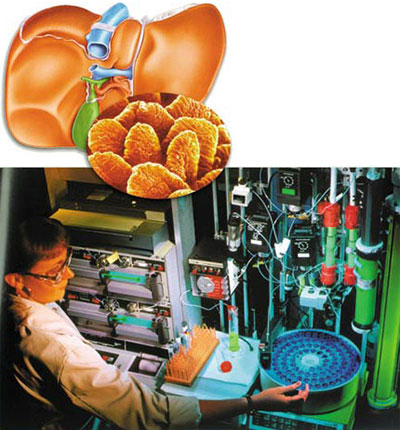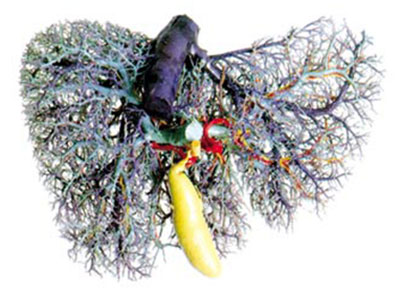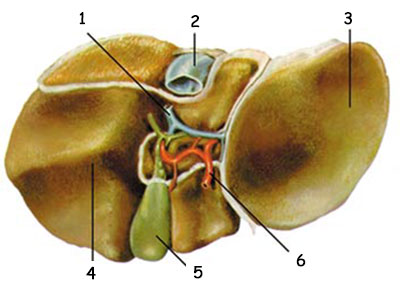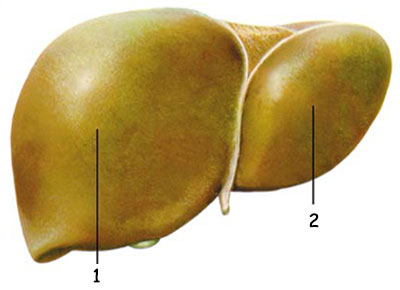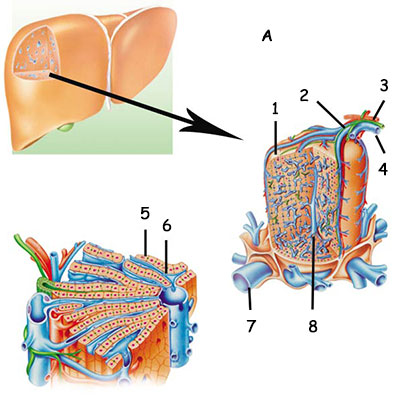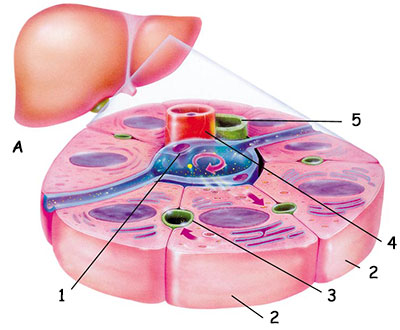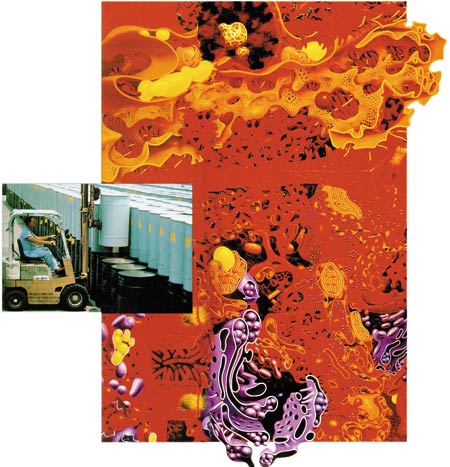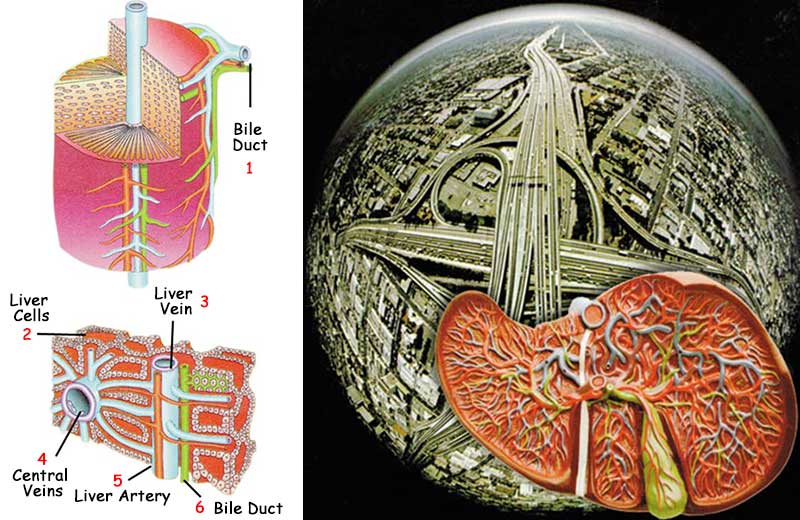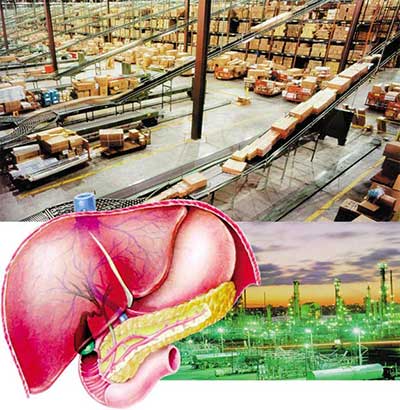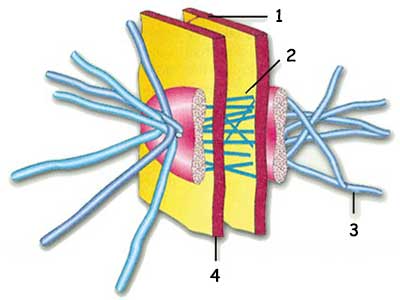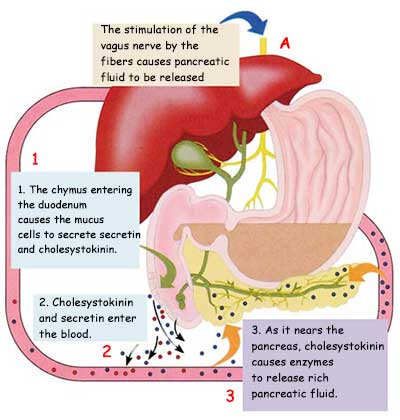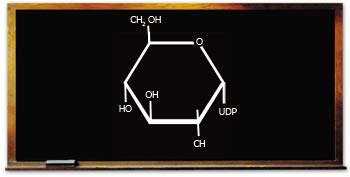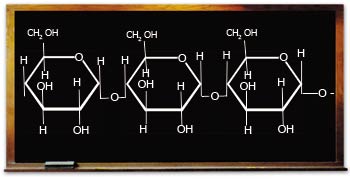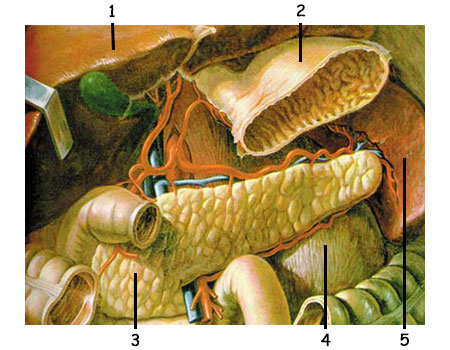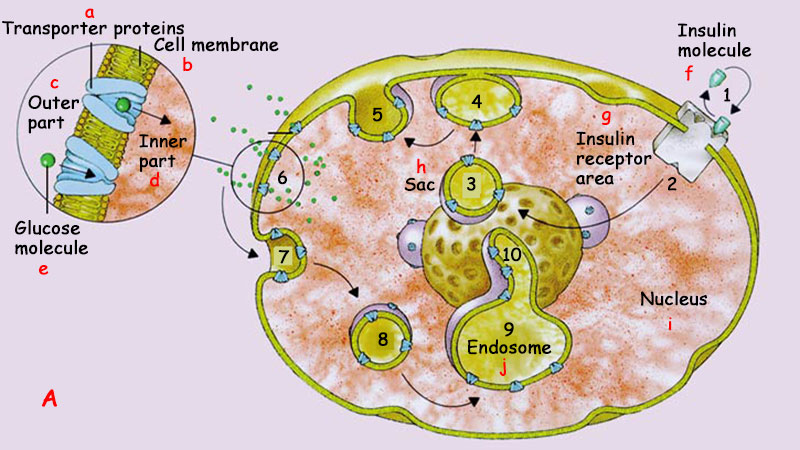Bigotry: The Dark Danger
The Human Miracle

DOWNLOAD THE BOOK
CHAPTERS OF THE BOOK
- Introduction: A Short Voyage Through The Human Body
- The Body’s Transport Network: The Circulatory System - 1/3
- The Body’s Transport Network: The Circulatory System - 2/3
- The Body’s Transport Network: The Circulatory System - 3/3
- The Digestive System - 1/3
- The Digestive System - 2/3
- The Digestive System - 3/3
- The Body's Purification Plant: The Excretory System - 1/2
- The Body's Purification Plant: The Excretory System - 2/2
- Splendid Communication within The Body: The Hormone System
- Your Internal Air-Conditioning: The Respiratory System
- A Resistant Structure: The Skeletal System
- Powerhouses in The Body: The Muscles
- Conclusion: Human Beings are Created By Allah
- The Deception of Evolution
< <
7 / total: 15
The Digestive System - 3/3The Independent Factory In Our Bodies: The Liver
In recent years, computer engineers have begun using the liver as a model, mainly because of the way the liver successfully performs many very complex functions at the same time. The liver serves around 500 functions related to the general running of the human body. 36 The liver ensures that all the food you eat is brought into a form that your body can use. In doing so, it breaks down the complex molecules arriving in the blood from the digestive system into molecules that can be used or stored. It subsequently sends the useful ones on to other cells, by way of the bloodstream. But harmful ones, those it subjects to a number of processes and sends them to the kidneys, where they are filtered and expelled from the body in the form of urine. The way that a 1.5- to 2-kilogram (3.3- to 4.5-pound) organ can take up all nutrients by way of the blood, process and expose them to various chemical reactions, and turn them into useful building blocks of benefit to other cells, is a miracle all by itself. Since the liver’s fundamental duty is to process the nutrients it receives by way of the blood, its structure must be appropriate to storing blood. Indeed, the liver has a spongy structure. In the human body, a total of 800 to 900 grams (1.7 to 2 pounds) of blood is in a state of absorption by the liver at all times. The special location of such a heavy organ has been determined in such a way as not to damage the other organs and for it to still perform all its functions. The Control System in the LiverThe liver’s operations may be compared to the workings of a port. In the same way that cargoes from different regions are collected at one spot and then forwarded on to other regions, substances necessary for the body are collected in the liver, and forwarded from there according to the body’s requirements. For blood loaded with raw materials to reach the liver depends on the blood vessels passing through the digestive tract and the heart. The veins connect organs together for specific purposes. In other words, it is impossible to find in any organ a vessel whose purpose is uncertain or which has no function. The veins that reach the liver are responsible for carrying blood in the right quantities and in the shortest time possible. Oxygenated blood from the heart’s left ventricle reaches the liver through the kidney arteries. Every artery in the body is directed towards the liver, as if they knew that blood had to reach it. The blood coursing through our bodies that meets the needs of all our cells must be carefully inspected before reaching its destination, and any deficiencies have to be identified and corrected. The liver cells now enter the equation. Blood from the stomach, intestines and spleen is sent directly to the liver, where it will be refined. It’s as if these organs, realizing the importance of the liver, had taken a joint decision to carry out their share of the job, and fulfill their responsibilities to it. If blood from the stomach, intestines or spleen went directly to the heart to be spread to the body’s cells, that would mean that substances that were not yet ready to use—or even harmful and poisonous—, would be distributed. That would constitute a life-threatening danger. Liver cells do not produce blood, which reaches liver cells from the outside. Despite blood being a foreign substance to them, the liver is well acquainted with its structure. Each liver cell knows just what blood should contain. If any substances are missing from the blood, it supplies them. If there are excess quantities of any substances in the blood, it stores them. In short, the liver cells possess an expertise that lets them fulfill their functions to the letter. In contrast to other organs, the liver receives blood from two different sources. The first is the connection that carries oxygen-rich blood from the arteries of the heart. The second is the arteries carrying nutrients from the stomach and intestines. These two sources reach the liver tissues separately and divide into sinuses inside it. After processing by the liver cells, the blood comes together and is released in a single vein. With all processes completed, the blood leaving the liver returns to the right-hand chambers of the heart and is pumped to the lungs, for dissemination to the body. As you’ve seen, the venous network among the organs and the order in which the blood needs to flow to various organs have been set out according to a specific plan, and the circulatory system has been constructed in light of that.
The Liver’s Special StructureThe tiny blood vessels tirelessly carry the blood, of such great importance for our survival, to the very furthest corners of our bodies. The walls of the capillary vessels, which become increasingly thin as they enter the depths of the tissues, are much thinner than those of the arteries and veins. Thanks to their porous structures, there is a constant exchange between the tissues and the blood of respiratory gasses, water, various minerals, salts, nutrients, wastes, hormones and antibodies. In contrast to other blood vessels, the walls of the capillaries in the liver lack a protective basal layer. Actually, “lack” may not be the right word here, since the absence is deliberate. While there is a basal layer in the other organs, thanks to its absence in the liver’s blood vessels, blood coming from the capillary veins is immediately soaked up by the liver cells, processed and sent to the body quickly and effectively. Thanks to this structure so well adapted to its functions, the liver is easily able to take blood into its spongy tissues, process it, release many proteins into the blood plasma, as well as taking in and eliminating old erythrocytes traveling through the bloodstream that have completed their life spans.
As another example to underscore the importance of this basal layer structure in blood vessels: It is easier for water to filter down through soft soil than through hard clay. Farmers frequently hoe their fields in order to increase the porosity of the soil for growing crops. Plants in soil that is not hoed enjoy only a limited benefit from rainwater. For minerals and water to reach their roots, the soil needs to have a porous structure. Thinking of the liver in the same terms, the blood vessels in the liver have no basal layer or “clay” and can thus transmit blood to the cells much faster.
Pools in the Liver: The SinusesIt is thought that more than 2 million sinuses in the form of fine cracks are found in the liver’s complex vascular structure. Their duty is to host the blood arriving from the outside and to play a role in processing it. The diameter of a sinus is so minute that erythrocytes can pass through one only by squeezing themselves. Such a delicate and fine structure functions throughout a person’s life, without ever being punctured or damaged. The reason why the sinuses have such a delicate structure is most amazing. For the liver to successfully synthesize or expel substances reaching it from the bloodstream, it’s essential that these substances reach the hepatocyte liver cells. Sinuses undertake this responsibility, and work expertly in the liver tissue through which they spread like tunnels. The carefully determined diameters of the sinuses, the wall structures and connections with other vessels are ideally suited to the work they perform. The open structures known as fenestrae (the Latin word for “windows”) in the walls of the liver sinuses allow particles in the blood less than 1/10,000 of a millimeter in size to reach the liver cells, while preventing larger ones from doing so. Were the sinuses any wider, then larger molecules could easily reach the liver cells and damage them.
Different Cell Structures in the LiverThere are two kinds of cell in the liver: epithelial cells and connective tissue cells. They fulfill their responsibilities with great discipline, never confusing or shirking their duties, because any problem that might halt this disciplined working system would mean death. For example, if the liver cells stopped storing glucose, cells would be unable to function through loss of energy even though foodstuffs entered the body, and the brain cells could not work, leading to death or permanent disability.
Yet such a thing never happens. The cells carry out all the needed production, in the exact manner required. Every liver cell has been created in line with a particular purpose. The liver is covered in a transparent connective tissue or membrane known as Glisson’s capsule, which serves a very important purpose. If we compare the liver’s structure to a sponge full of liquid, this membrane resembles a bag around that sponge, ensuring that compounds do not leak out from the liquid-filled liver. Thanks to this connective tissue, the liver maintains its structure and keeps its contents, and also keeps separate from other organs.
The connective tissue cells cover and protect the liver, but the liver cells 1 millimeter (0.04 inch) underneath have very different duties. It’s astonishing that cells so close to one another should perform such different functions. During embryonic development in the womb, some cells turn into those that will constitute the liver, and other cells immediately nearby turn into transparent cells that subsequently combine together and form a membrane entirely enfolding the liver, preventing any fluid from leaking out. Two different groups of cells have emerged, contiguous but very different in terms of their tasks and appearance. There is a definite borderline between these two cell groups. Each cell was born knowing its duty and responsibility and where it had to be. While the body is still growing in the womb, it is constructed in a precisely ordered form. The liver cells’ physical structures have been separately and specially created according to their location and what function they will undertake. For example, the walls of the cells touching the membrane surrounding the liver are all flat, because there is no exchange of substances between the liver cells and the membrane. In regions where there is a heavy exchange among cells, the situation is different. On the walls of these cells, minute protrusions called microvilli stretch out towards the neighboring cells, permitting greater contact between the cells and the blood fluid, so that substances can be exchanged more easily. Enzymes that speed up and halt chemical reactions have also been located in regions containing these protrusions, and all the means necessary for substance exchange are in place. That the liver’s cells possess the ideal physical and chemical properties for their functions and location shows that every detail in this organ has been set out in line with a specific plan: Everyone in the heavens and Earth belongs to Him. All are submissive to Him. (Surat ar-Rum: 26) The Liver’s Canal SystemThe liver possesses a special transportation system containing millions of channels. The two main veins carrying blood to the liver, once inside it, divide into millions of tiny capillaries. Moreover, inside the liver there are also channels that carry gall bladder secretions and are laid out parallel to the blood vessels. What is the significance of these millions of micro-channels in a piece of tissue weighing between 1.5 and 2 kilograms (3 to 4.5 pounds)? This channel system is a specially built marvel of creation whose importance can be better understood when you recall the functions of the liver cells, the amount of blood reaching the organ and the liver’s general function. The liver refines molecules in the blood, turns them into other substances and when necessary, stores them. All these processes are carried out by millions of tiny chemical laboratories—the liver cells—and a special connection needs to be provided for each cell, and molecules about to be refined need to be carried right up to it by the blood. This channel system possesses the ideal creation for meeting this need. The millions of micro-channels inside the liver have been constructed in such a way as to never conflict with one another or to disrupt each other’s functions. The transportation of the raw materials to be processed and of substances in the liver produces takes place along these channels. To better comprehend the flawless nature of this creation consider the following example: Imagine you have paid a short visit to one of the most developed and best planned cities in the world, and have investigated that city. Its infrastructure is flawless. With regard to transportation in particular, every possible measure has been taken and a great many facilities have been laid on for its inhabitants. A large metro system is built under the city’s surface, connecting all the regions of the city to one another. The metro network is hundreds of kilometers long, with stations all along that length. Perfect urban planning has also been carried out on the surface. Thanks to the city’s large number of rationally planned main roads and highways, traffic never becomes congested, no matter how busy the city, and there is never any transportation delay. At the same time, the roads’ superstructure has also been flawlessly planned. Roundabouts and signal lights direct the flow of traffic, and signposts along the roads make things easier for out-of-town drivers.
This advanced city is an important commercial and industrial center. Its roads are used at all hours for the transport of commercial and industrial goods. How would you react if someone told you that the city had never been planned at all, that it was not deliberately built, and that its roads, and industrial and commercial centers all came into being through chance and by themselves? Rather than wondering whether that person’s words were true, you would wonder whether the individual was sane. When the urban planning cited in this analogy is compared to the channel system inside the liver, the former is much simpler than the latter. Every pulmonary channel has been opened for a specific purpose, to fulfill a specific function. The molecules produced or processed in the liver move through these channels in breathtakingly busy traffic, yet without any disruption taking place. The channels are surrounded by cells that engage in production, storing and transformation, carrying out processes far more complex than those in any factory or industrial center, and continue production around the clock. A highly efficient transportation network has been provided for an extraordinarily productive industrial and commercial zone. Quite clearly, any such well-planned system must have been created. Great planning can be seen in every feature of the human body, not solely in the liver. Molecules invisible to the naked eye travel through painstakingly constructed channels to reach their required destinations. The continuity of this transportation is of the greatest importance to human life. Scientists and doctors have spent years researching and investigating the organ in which these molecules will be stored, the level at which they will be present in the blood, and whether or not they will be expelled from the body. Indeed, the branch of science known as molecular biology makes a special study of the behavior and function of molecules it has identified in the body. The information obtained so far, however, can account for only a small part of the body’s functioning. Trained minds are investigating these bodily systems using the very latest technology, but still failing to fully understand them. It’s impossible for these systems to have come into being by themselves. Claims that base their coming into being by chance are quite laughable. Nobody would claim that a road interchange made of asphalt came into being by itself. That being so, it is utterly illogical to believe that a flawless planning system composed of such delicate substances as flesh and blood, thousands of kilometers long, was created by chance. Allah created all this flawless system. Everything happens as He so wills it. Special Capabilities of the Liver CellsThe liver is seemingly aware of all the activities taking place in other, different places in the circulation, digestive and respiratory systems. For example, it knows beforehand that the fats entering the digestive system will be unable to be dissolved, and it produces the chemical necessary for those fats to be broken down and digested in its laboratory. As you already know, that substance is bile, or gall. The liver stores this substance it produces and subsequently, on receipt of a command, sends it to help digest fatty foods at exactly the right moment. The organ that performs all these functions consists solely of flesh and blood. However, the liver is aware of everything going on in the digestive system and produces bile as a precautionary measure, meaning that it possesses considerable foresight. The capacities of the liver cells go even further than this. As a result of this organ’s constant activity, a number of waste products emerge. It’s essential that these be expelled if the liver is to continue functioning. The Kupffer’s cells on the sinus surfaces fulfill this role by swallowing and digesting harmful substances in the blood by the method known as phagocytosis. Danger is eliminated by these cells carrying out an accurate distinction between useful and harmful substances. 37 What if these cells did not identify and eliminate harmful substances in the blood? Diseases would constantly break out in the body, and the immune system would be in a constant state of mobilization, leading us to feel always ill and fatigued. Yet thanks to this special system in the liver, the body’s enormous army does not proceed to action stations, while the Kupffer’s cells—which may be compared to a border police force—eliminate harmful substances. This precaution for the benefit of human health is part of Allah’s affection for the living things He has created. All those who think on this information using their conscience and reason will reach only one conclusion: Allah is the Almighty, the Worthy of All Praise. Multi-Functional Workers in the LiverThe hepatocytes, or the basic liver cells, perform a number of functions, including the secretion of bile, cleansing the toxins from the blood, distinguishing between proteins and carbohydrates and fats, and producing the particles that are stored in the blood and used for coagulation. Each of these functions is very important for us to lead healthy lives. It is thought-provoking, too, that the same liver cells should carry out so many different processes. Each of these chemical reactions combining substances such as carbon, hydrogen, oxygen and nitrogen requires a separate expertise. Their being performed by the same cells, requires a system, order and planning, and the fact that the details are carried out by cells that can be observed only under an electron microscope is one worthy of deep amazement. Imagine that we try to establish a human community that will perform all the processes our livers carry out for us. We will need to find: An expert on the subject of chemical reactions, A staff to work in production, A space to store the necessary materials, A way to dispose of the waste products arising during production, in such a way as not to harm those working in the factory or to pollute the environment, To offer additional services to nearby factories and produce in advance such materials as they may need, To settle disagreements with nearby factories ... And a great deal more. At the same time, each of these workers—just like the liver cells—must have experience in all these areas. They must work non-stop, never feel tired, and be able to assume single-handed responsibility for everything they do. As you might expect, it will be quite impossible to find individuals with all these characteristics to undertake such a responsibility. Yet millions of cells, visible only under the microscope, are performing all the tasks just listed and many more, in a perfectly flawless manner, just under your diaphragm. Moreover, they are performing these same tasks and in just the same flawless way in the livers of everyone alive today, and in the livers of everyone who has ever lived. This magnificent intelligence exhibited by trillions of cells, themselves made up of molecules, is clearly not their own. Some Functions of the Liver, Which Acts Like a HeadquartersThe liver consumes 12 to 20% of the body’s total energy in performing its various functions, known to number around 500. Some of the areas in which the liver acts just like a central headquarters are the following: It Regulates the Nutrients Necessary for the CellsThe liver makes the necessary adjustments for each of the 100 trillion or so cells in our bodies to be able to receive the nutrients they require. In so doing, it must know just what the cells need. Yet where does this organ, itself made up of similar cells, collect the requisite information? How does it interpret it, and how does it arrive at the correct decisions? It Takes up the Raw Materials Necessary to Produce Nutrients
The raw materials the liver uses to carry out production are carried in the blood. In the same way that a factory receives raw materials from various loading docks and then turns them into very different items, so the liver constantly synthesizes the raw materials that reach it, stores or uses them, or returns them to the body in the bloodstream, ready to be disposed of. It Stores Materials that the Body NeedsThe liver, comparable to a giant laboratory in which chemical reactions take place, also ensures the storage of various substances essential for survival, such as iron, copper, Vitamin A and Vitamin D—and also produces a number of them by itself. In addition, the liver produces proteins such as heparin, fibrinogen and prothrombin, responsible for blood coagulation. It Produces the Proteins Essential for LifeOne of the liver’s main functions is to synthesize needed proteins. The liver knows what it has to do without having received any training at all, uses the correct method to distinguish nitrogen molecules belonging to amino acids given off as a result of digestion, and produces new proteins by having these substances react with carbohydrates and fats. It also produces such materials as carbohydrate by using fats and proteins. From carbohydrate and protein, the liver is capable of producing fat which it stores to be easily turned into energy later. It Supports the Immune SystemAs already pointed out, the liver is an important component of your body’s immune system. It makes no mistakes in finding harmful substances, neutralizing and disposing of them. Special phagocytes in the liver clean foreign bodies and bacteria from the blood. The liver also neutralizes the toxic effects of drugs, thus preventing any poisonous side effects from the medications you take when you are ill. Working literally like a security system, the liver identifies all the harmful substances that reach it by way of the bloodstream. Were it not for liver cells recognizing and taking appropriate measures to deal with harmful substances that reach the liver through the bloodstream from the stomach or the intestines, then simple bacteria—or the drugs we take for health purposes—would leave us suffering one illness after another. All these processes, essential to our survival, are carried out non-stop by an organ weighing only 1.5 to 2 kilograms (3 to 4.5 pounds.) All these processes are taking place even as you read these words. Even a momentary pause in this miraculous system would lead you to an incurable illness or even death. The liver, which performs all these functions, is itself an organ composed of basic building blocks such as protein, fat and water. That it possesses much greater expertise than a human being—who will learn to perform a few chemical reactions only after years of training—and the way that every chemical reaction ends successfully, is quite astonishing. Every liver cell knows which substances will be used in our bodies, as well as the molecular and chemical structures of these substances. They thus turn the nutrients they identify into useful substances, but in so doing, they know that they also need vitamins and enzymes to synthesize protein. They know that iron constitutes the basis of producing erythrocytes, the fundamental building blocks of blood, and that the level of sugar in the blood needs to be kept at an even level! But liver cells are unable to perform any of these processes of their own accord. They cannot learn one single piece of information about the substances in our bodies. It is our Lord Allah Who inspires the liver cells the knowledge of which substances are to be processed, which are useful or harmful, and which need to be stored for later use. A Maintenance-Free SystemAs already described, the renal artery and the hepatic veins carry blood to the liver and bifurcate into small branches inside the organ. Some 1.5 liters (0.4 gallons) of blood per minute passes through the liver by means of them. This means that 90 liters (23.8 gallons) of blood passes through the liver every hour; and the liver processes 2,160 liters (0.6 gallon) of blood a day. Moreover, 1.5 tons (1.6 short tons) of protein and 12.5 tons (13.7 short tons) of carbohydrates enter the liver in an average human lifespan of 70 years. This system may be thought of as a giant refinery working non-stop, 24 hours a day, and functioning with a computer-controlled command system. Assuming that one working day began as soon as the previous one came to an end, one might well expect the refinery machinery to require maintenance. Even with a very modern, advanced refinery, we would have to spend at least half a day every week checking its components. Yet what we are discussing here is an organ in our bodies that works far more intensely than any refinery. The liver takes in tons of substances, processes them without making any concessions, and turns them into forms that the body can use. In addition, despite working non-stop, never tiring or needing a rest, it never requires any maintenance that might slow the system down. This is the superior and incomparable creation of Allah. He is the Living—there is no deity but Him—so call on Him, making your religion sincerely His. Praise be to Allah, the Lord of all the worlds. (Surah Ghafir: 65) The Liver’s Ability to Regenerate ItselfThe liver is the only organ in the body capable of regenerating itself. Even if up to 70% of the liver is removed, within a week or two it again reaches a size capable of performing all its functions. The mechanisms responsible for the regeneration of the liver are still being researched. This feature of the liver was first revealed by studies by two surgeons in the Mayo Clinic in 1931. It was realized that the liver regenerated itself in a great many species, and that the cells initiate this process automatically in the wake of any damage. Yet cells in a healthy liver are never observed to multiply of their own accord. That being so, why do they divide and multiply when this organ requires it, and do so until the liver has once again attained its former dimensions? How do the cells know for how long they need to multiply, or when to stop? Where do the commands come from? In the absence of a command to stop, do they decide for themselves not to increase to the extent of putting pressure on other organs? Whenever liver cells are subjected to any harm or damage, they suddenly begin multiplying by initiating a most unexpected activity. The astonishing thing about this phenomenon is that the cells divide at unbelievable speed, while still performing their normal functions to the letter. It is even more surprising how they take a joint decision on when the process should stop, once the necessary steps have been taken. It is thought that damage to the liver sets into motion a number of factors that create a multiplication in the cells. These growth factors are perceived by receptors on the liver cells and give rise to complex activities inside them. New programming thus begins at the genetic level, and the requisite activity for multiplication of liver cells is initiated. The same subject has been investigated by geneticists, who examined the method used by self-regenerating cells in the liver and their levels of activity. These studies investigate what are known as proliferating hepatocytes and the path they follow from inside the liver. A single hepatocyte can regenerate a rather large part of the liver. During the division and multiplication process, it was observed that new cells in the liver do not move, although old hepatocytes do. During the regeneration process, cells at the center of the liver and other cells emerge from the portal region and move towards the kidney vein. This mass movement may be compared to a walk. Since the cells move in only one direction, the further a cell is from the center, the older it is. In this way, cells’ age can be calculated by means of their distance from the center.
The proliferating-tissue theory proposed with the investigation of the movements of aging liver cells is one that every newborn cell knows very well and immediately puts into practice. Whenever one of the cells divides, one of the newly formed cells has to move. Following the division of the cell into two, in the process known as mitosis, one of the new- formed cells takes the place of the original cell, and that cell proliferates forward to the site of connection. When a cell divides, the new cell remains in place of the old one, and the original “mother” cell moves forward a little. However, in order for this cell to assume its new place, all the other nearby cells have to slide outwards. But as we’ve seen, these cells are neither pushed nor pulled, and perform no mechanical activity. The phenomenon that takes place is described as proliferating and takes place very quickly. It is Allah Who gives the requisite commands and Who regulates and creates this miraculous process from beginning to end. In the verses of the Qur’an, it is revealed that Allah regulates the existence and working of every system on Earth, and that people must study and consider this knowledge: It is Allah Who created the seven heavens and of the Earth same number, the Command descending down through all of them, so that you might know that Allah has power over all things and that Allah encompasses all things in His knowledge.(Surat at-Talaq: 12) The Body’s Secret Supporter: The Pancreas
Imagine you have a delicious dinner. You may never have wondered how you will digest those various nutrients. You are likely unaware that each of these nutrients need to be processed by different enzymes. of course, it’s perfectly natural for anyone who has not received specialized training to be unaware of this. Yet one organ in your body does possess all this information. It knows which foodstuffs will be digested by which enzyme, and sends the right chemical secretion to these foodstuffs, at the proper time, with no confusion or stoppages ever occurring. That organ is the pancreas. One of the most important organs in the body, the pancreas decides how many sugar molecules need to be present in the blood flowing through the veins. If there is a reduction in the number of sugar molecules in the bloodstream, the pancreas immediately takes steps to raise that number, and those measures save the life of the individual. If the sugar-molecule concentration rises, then it takes steps to lower their amount in the bloodstream. With the enzymes it sends to the digestive system, the pancreas plays a major role in human health. The enzyme that prevents the intestines being digested by stomach acid is also produced by the pancreas. If we examine these functions one by one, then we can see how this organ, which may never have drawn your attention, acts in a most planned, conscious manner and possesses a flawless system that keeps you alive. The pancreas’ intervention in the digestive system begins with a special signal. As digestive processes carry on inside the stomach, specific quantities of a special enzyme known as cholesystokinin enters the bloodstream and stimulates the pancreas to secrete breaking-down enzymes into the duodenum. 38 The Hidden ChemistThe pancreas not only understands that the digestive process has begun. It can also understand the kind of foods you have eaten, and then produces different digestive enzymes accordingly. For instance, when you eat a lot of carbohydrates, such as pasta or bread, when these foods reach the duodenum, the pancreas secretes the enzyme amylase, which possesses the feature of breaking down carbohydrates. If you eat meat, fish or chicken, when these high-protein products reach the duodenum, the pancreas produces enzymes such as trypsin, chymotrypsin, carboxypeptidase, ribonuclease and deoxyribonuclease, which then break down the protein molecules. If your meal has a high fat content, then lipase, another enzyme that digests fats, enters the duodenum together with these other enzymes. This organ realizes the content of the food you eat, then separately produces the chemical fluids necessary to digest these foods, and secretes them only at the right time. The pancreas never secretes enzymes that break down protein for carbohydrates, or fluids that break down carbohydrates for fat molecules. It never forgets the chemical formulae of the complex enzymes it produces, or accidentally leaves out any components. In the healthy individuals bodies, the pancreas serves accurately for a whole lifetime.
For a closer look at the scale of the miracle involved, let’s examine this phenomenon at the micro level. As digestion proceeds, the stomach cells do not remain idle. Some of these cells realize that the food being digested will later reach the duodenum. Their sole concern is that this food should be digested as well as possible. By means of the bloodstream, the stomach cells signal to the pancreas cells to assist them by secreting a hormone. The signal they deposit travels through the bloodstream and when it reaches the pancreas, the cells there immediately recognize it. Although it travels through just about the whole body, the signal is not opened and in particular, not read, by the other organs. All other cells know that this signal has been addressed to the pancreas, not to them. That is because the molecular structure of the signal has been so created to affect only the receptor molecules on the membranes of pancreatic cells. In other words, the stomach cells have written the correct “address” on the hormone it produced in a conscious, knowledgeable way. In order for that address to be written properly, the stomach cell needs to know all the features of a pancreatic cell.
The miracle is not solely restricted to the correct writing of the address. The letter sent by the stomach cell also contains a message. Two tiny cells in the depths of the human body, located far away from one another, correspond and communicate to serve a specific purpose. Though they have never seen one another, they know the language the other will understand and act together to plan for the digestion of the food you eat. No doubt this is a true miracle! The pancreas reads the message reaching it, in the form of the hormone cholesystokinin, and loses no time in secreting the necessary enzymes. If the food reaching the duodenum is a protein, then it produces an enzyme that breaks down protein and sends this to the duodenum. If the food is heavy in carbohydrates, then it produces an enzyme that breaks down carbohydrate. Imagine a blackboard on which are written the formulas for a protein molecule, a fat molecule and a carbohydrate molecule, together with plans of these molecules’ atomic chains. Then imagine that someone asks you to produce the chemical formulas for the best enzymes to break down each one of these three different molecular structures, and to write them down on the blackboard. Unless you have received specialized chemical training, you could never guess the most ideal formulas that would break down these molecules. You could write down those formulas only in the light of previous training or instruction. That being so, then how do pancreatic cells know the chemical formulas of the enzymes they produce? Each and every pancreatic cell knows these formulas from the moment it comes into being. Moreover, it constantly uses that information in the most accurate manner to serve the body as a whole. In terms of chemistry, pancreatic cells are far more knowledgeable than human beings! Humans require special training to produce these formulas, whereas a tiny cell knows them all by heart right from the start. No coincidence can provide cells with such special information and a superior sense of responsibility. No coincidence can ever build a system by which cells can communicate with, and seek assistance from one another. No coincidence can teach a single cell even one chemical formula. No coincidence can endow the cell with the capacity to use whatever information it possesses at exactly the right time. It is Allah, the Lord of the Worlds, Who created all these systems from nothing and placed them at the service of human beings by ensuring they work at every moment. Another of the pancreas’ important functions is regulating the body’s blood sugar levels. The secretions that perform this function, called insulin and glucagon, are emitted by small, closed glands in the pancreas known as the islets of Langerhans. 39 As you sip tea or eat a piece of cake, your need to regulate the level of sugar in your bloodstream never occurs to you. You may never even realize how vitally important this constant regulation is. Your pancreas, however, responsible for your ongoing health in this area, possesses all the information to adjust your blood sugar levels in a particularly sensitive manner. When necessary, it secretes sufficient amounts of hormone to protect the level of sugar in your body.
It is essential for life that the amount of sugar in the blood should be within specific limits. Yet we need not calculate that sensitive balance as we eat sugary foods in our daily lives—because that calculation is performed for us. When the level of sugar in the blood rises, the pancreas immediately becomes aware of it and secretes a special substance known as insulin, which instructs the liver and other body cells to keep hold of the excess sugar. If the level of sugar in the blood falls, then the pancreas learns of this, too and secretes the hormone glucagon. The liver then releases into the blood the sugar stocks it has previously stored by means of special processes. 40 Thanks to this, the blood level of sugar never reaches dangerous levels, except during cases of diabetes. In your day-to-day life, you will be quite unaware of the pancreas, its insulin and your liver. You will not feel that your blood sugar level has risen. Even if blood samples with two different amounts of sugar in them are placed before you, you will be unable to tell the difference. Yet some of your cells, which you have never seen, measure the levels of sugar in your blood far more sensitively than any laboratory could, and immediately decide on the steps that need to be taken.
How did your cells come by this incomparable intellect and ability? Of course, your cells did not give themselves the intellect and ability with which to make measurements, make decisions and put them into practice. It is Almighty Allah Who creates the cells in your body with such a flawless system, gives them the necessary commands, and makes them aware of how they must behave. In our description so far, we have used such verbs as knows, makes, and produces. Bearing in mind that the pancreas is also composed of cells, you can immediately see that these actions require reason, and cannot be attributes of the pancreas itself. That being so, who gave the cells of the pancreas their ability to produce for an entire lifetime and endowed them with their sense of responsibility? Who taught the pancreatic cells the chemical formulas of enzymes that break down so many different complex molecules? Who provided the duct system to allow the fluids they produce to empty into the correct locations? Who established the warning and communications systems to allow the right enzymes to be released at the right time? These questions and hundreds of similar ones lead us to one evident truth. It is Allah Who does all this. Allah reveals Himself to us with such magnificent features as these, which He has installed in such a tiny volume. This is the most important fact in anyone’s life. Say: “Who is the Lord of the heavens and the Earth?” Say: “Allah.” Say: “So why have you taken protectors apart from Him who possess no power to help or harm themselves?” Say: “Are the blind and seeing equal? Or are darkness and light the same? Or have they assigned partners to Allah who create as He creates, so that all creating seems the same to them?” Say: “Allah is the Creator of everything. He is the One, the All-Conquering.” (Surat ar-Ra‘d: 16) Why Is the Pancreas Not Harmed by Its Own Secretions?
The pancreas secretes so many dissolving enzymes, yet does not digest itself. The pancreas, with a basically protein structure, remains unaffected by any of the dissolving enzymes it secretes. This protective system comes about in a most astonishing, miraculous way. The pancreas first produces its enzymes in a non-active form, in which they are unable to break down proteins—and therefore, the pancreas itself. When released into the duodenum, however, the enzymes combine with a very special substance produced only in this region of the body, and immediately begin to change. Enzymes combine with the substance known as enterokinase, produced in the small intestine, and suddenly assume active form, acquiring the ability to break down proteins.41 The way that one substance secreted in the pancreas joins together in complete harmony with another secreted in the intestines is a considerable wonder. These two molecules have never met before, having been secreted in different regions. Yet these two independent molecules complement each other flawlessly, and serve a common purpose. This miraculous phenomenon cannot, of course, be explained in terms of chance. What is more, the miraculous systems that prevent the pancreas from digesting itself are by no means limited to this. The pancreas secretes another protein-digesting enzyme called trypsin and at the same time, secretes another special substance known as a trypsin-inhibitor to prevent the trypsin from dissolving the pancreas. These two enzymes, have no effect when secreted together, separate from one another when they reach the duodenum. This in a way liberates the trypsin, which begins to break down the protein in the foods arriving at the intestines. 42 Were these two substances to separate earlier, it would dissolve the pancreas itself. If they never separated from one another, then the trypsin would be unable to break down proteins. However, as this example shows, everything happens at the right time and in the right place. The pancreas knows it must secrete the necessary substances at just the right time, and the enzymes go into action only after dividing from each other. Clearly the cells composing the pancreas, and the molecules that make up its enzymes, could never form such a flawless system, nor establish such perfect order within the human body of their own accord. Anyone reasonable can see that such a system, which works with no gaps and no confusion in the order of tasks performed, and with the same flawlessness in all human beings, is the product of a superior Intellect and a flawless Creation. It is impossible to account for this system in evolutionary terms. This system is one of the manifest proofs of Allah’s creation. Allah reveals these signs in this and other such examples to those able to use their minds and who are able to see. It is He Who appointed the Sun to give radiance, and the Moon to give light, assigning it phases so you would know the number of years and the reckoning of time. Allah did not create these things except with truth. We make the Signs clear for people who know. In the alternation of night and day and what Allah has created in the heavens and the Earth there are Signs for people who guard against evil. (Surah Yunus: 5-6)
Footnotes36.Solomon, Berg, Martin, and Villee, Biology, p. 962. 37.Arthur C. Guyton – John E. Hall, Textbook of Medical Physiology, Guyton & Hall, W.B. Saunders Company, 1996, p. 885. 38.Solomon, Berg, Martin, Villee, Biology, p. 967 39.Prof. Dr. Ahmet Noyan, Yasamda ve Hekimlikte Fizyoloji (“Physiology in Life and in the Field of Medicine”), pp. 881-882. 40.Arthur C. Guyton and John E. Hall, Textbook of Medical Physiology, Guyton & Hall, p. 978. 41.Prof. Dr. Ahmet Noyan, Yasamda ve Hekimlikte Fizyoloji (Physiology in Life and in the Field of Medicine), p. 879 42.Biological Science: A Molecular Approach, Sixth Edition, D.C. Heath and Company, Massachusetts, p. 412. |
|||||||||||||||||||||||||||||||||||||||||||||||||||||||||||||||||||||||||||||||||||||||||||
7 / total 15
You can read Harun Yahya's book The Human Miracle online, share it on social networks such as Facebook and Twitter, download it to your computer, use it in your homework and theses, and publish, copy or reproduce it on your own web sites or blogs without paying any copyright fee, so long as you acknowledge this site as the reference.
